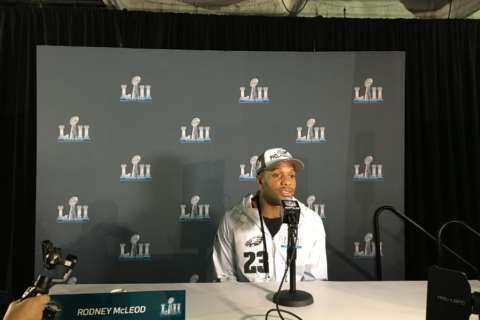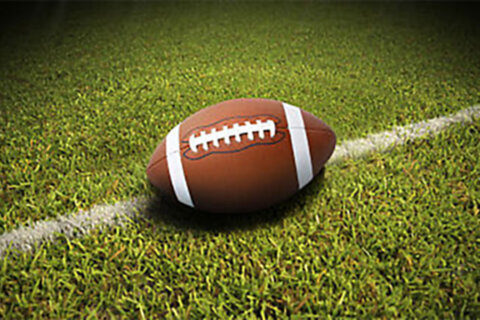BLOOMINGTON, Minn. — Facing Gwynn Park High School as a cornerback for Potomac High School in 2010, Ronald Darby slipped and fell to the ground.
A Gwynn Park receiver was caught up in a scrum of defenders. Darby figured his foe would get tackled, so he did not immediately get up.
Then the opposing wideout broke away with a clear field to the end zone. Darby, now with the Philadelphia Eagles, stood up and sprinted. He caught the receiver 40 yards down field and stripped the ball loose.
“Darby had a chance to fall down, cross his legs, look at our kid get in front, get up and catch him,” Gwynn Park football coach Danny Hayes told Capital News Service.
Darby’s speed, which carried him to Florida State University and the NFL, was the main reason he stood out at the Oxon Hill, Maryland school. He was recognized as Maryland’s second-best class of 2012 football recruit and was one of the fastest high school track-and-field sprinters in the country.
“I’m just naturally fast,” Darby, who still carries around his USA Track & Field backpack from high school, told a small group of reporters at the Mall of America on Wednesday. “It’s in my genes.”
While Darby has endured injuries since then, his quickness helped him earn a starting role in each of his first three NFL seasons, now as cornerback with a team trying to win its first-ever Super Bowl. He’s recorded three interceptions in nine games this season on a defense that’s allowed 17 points in its two playoff games.
The Eagles play the New England Patriots in the Super Bowl on Sunday at 6:30 p.m.
“Darby is by far the fastest guy I’ve seen in a high school uniform,” Hayes said. “Darby’s gonna do what Darby wants to do.”
Darby said he always won suicide sprints when he started playing football at eight years old, claiming his quickness came naturally. When Darby was a freshman at Potomac, football coach Ronnie Crump said Darby ran a 4.31 40-yard dash, which led colleges to contact him and Darby every week.
Coaches from different colleges bumped into each other at Potomac. Whenever Notre Dame’s coaches visited Darby, they’d call him “nitro” to try to flatter him, Crump said.
Crump usually develops plans for his players to try to make the NFL, but Darby was the only player Crump knew would play professionally from his freshman year.
The only way Hayes tried to game-plan for Darby, who played running back and cornerback, was to force him into the middle of the field.
“You can’t even see Darby when he hits that corner and goes down the sideline,” Hayes said. “If you blink, you might have an 80-yarder against you every single time.”
During Darby’s sophomore season, Potomac played against Central High School on a muddy field after it had rained all day, so players could hardly run without slipping. The only offense that night came from Darby’s three punt returns for touchdowns. Crumb said Darby accounted for about 90 percent of the Wolverines’ yards in another game against Largo High School, scoring five touchdowns.
During the spring, Darby dominated the track, winning the Maryland 3A state championship in the 100 meters, 200 meters and 4×100 relay as a senior. He won a bronze medal in the 2011 World Youth Championships in Athletics, where the top high school track athletes around the world competed in France. Darby was one of six American men selected to represent USA Track & Field in a friendly meet in Japan in 2011.
Potomac track-and-field coach Stan Mullins taught Darby a better sprinting technique and improved his knee lift for acceleration, which helped him in both sports.
While using the leg press machine in the Potomac weight room one afternoon, Darby’s hip flexors popped up over his shorts and caught the attention of his teammates and Mullins. Darby had unusually strong leg muscles, Mullins said.
“When you have a kid that’s natural like that, the only thing you have to do is point them in the right direction,” Mullins said, “and keep their head straight.”
Darby hoped for a longer career by playing cornerback instead of running back in college. But he also wanted to run track for a backup option, which was one of the reasons he committed to Florida State.
Darby looked up to former NFL cornerbacks Deion Sanders and Darrell Green, who also ran track in college. He wanted to emulate that speed. But he endured a groin injury entering Florida State, forcing him to focus on football.
Darby still won the 2012 ACC Defensive Rookie of the Year. After nabbing two interceptions his sophomore season, he started every game the next year and won the 2013 national championship, a happiness Darby hopes to experience again Sunday.
“Super Bowl will probably be more of a better feeling,” Darby said. “That’s a lot harder than college.”
After Darby ran the seventh-fastest 40-yard dash at the 2015 NFL Combine, the Buffalo Bills drafted him with the 50th overall selection. He started all 29 games he played in and recorded a pair of interceptions over his two seasons there. In August, the Bills traded Darby to the Eagles for wide receiver Jordan Matthews and a 2018 third-round draft pick.
Darby dislocated his ankle in the first game of the season and was carted off the field, missing eight games. Since his return, Darby’s helped bolster a position group that was one of the Eagles’ weaknesses in preseason.
“That’s a good thing that it happened early on, rather than later,” Darby said. “I’m able to play through the postseason.”
The 5-foot-11-inch, 193-pound cornerback will often play off his receiver, making it appear as if he’s not tightly guarding, then use his speed to intercept or knock down a pass. Darby will continue to lean on that skill Sunday, when the Eagles face Tom Brady, arguably the greatest quarterback of all time, in the Super Bowl.
“He’s got it all: Speed, quickness,” Eagles safety Corey Graham said Wednesday. “He’s one of the fastest guys I’ve played with.”






